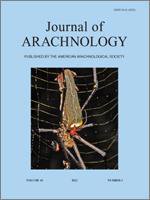Spitting spiders (Scytodidae) have a distinct predatory strategy in which they eject a sticky secretion from their cheliceral fangs to immobilize prey. This behavior could potentially allow the spider not only to avoid defensive secretions but also to bite specific vulnerable spots of a potential prey such as a harvestman. We used an ethogram, a fluxogram and an experiment to analyze the interaction between the harvestman Discocyrtus invalidus Piza 1938 (Arachnida: Opiliones) and the syntopic spider Scytodes globula (Nicolet 1849) (Arachnida: Araneae). These spiders, while readily taking crickets as prey, seldom spat at and never bit the harvestmen, which apparently did not exude repugnatorial secretions. We therefore tested, by clogging the glands and using appropriate controls, whether non-visible amounts of secretions could cause the rejection, but the harvestmen were still refused. This is the first detailed and quantified description of an interaction between a spitting spider and a harvestman. The general conclusions are that S. globula avoids preying on D. invalidus, S. globula behaves differently when attacking harvestmen and crickets and the scent gland secretions of D. invalidus do not play a direct role in this predator-prey interaction.
How to translate text using browser tools
1 November 2012
Behavioral analysis of the interaction between the spitting spider Scytodes globula (Araneae: Scytodidae) and the harvestman Discocyrtus invalidus (Opiliones: Gonyleptidae)
Luanda Abrão Carvalho,
Elene da Silva Souza,
Rodrigo H. Willemart
ACCESS THE FULL ARTICLE

The Journal of Arachnology
Vol. 40 • No. 3
November 2012
Vol. 40 • No. 3
November 2012
chemical defense
foraging
Laniatores
prey capture
scent gland




